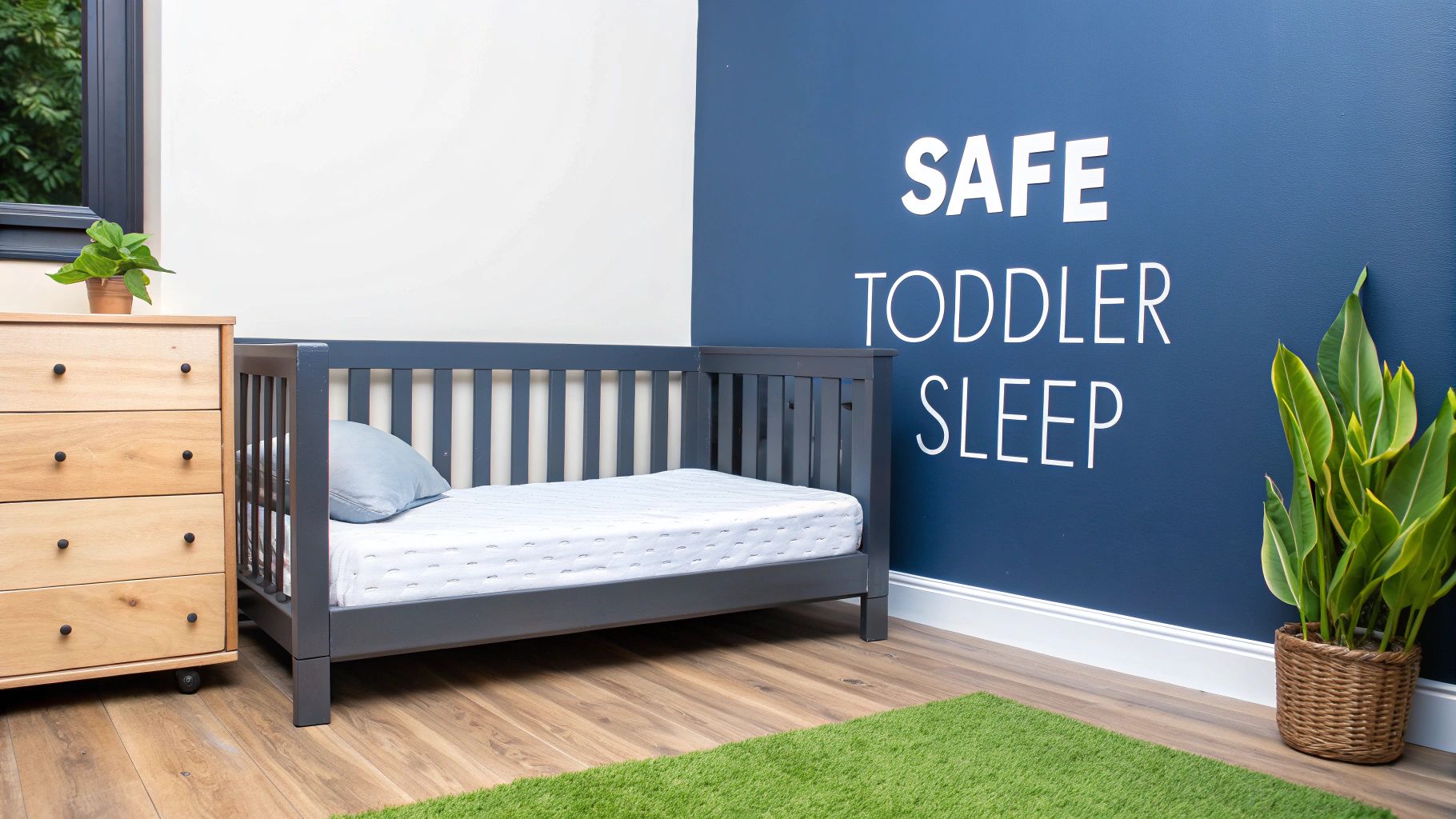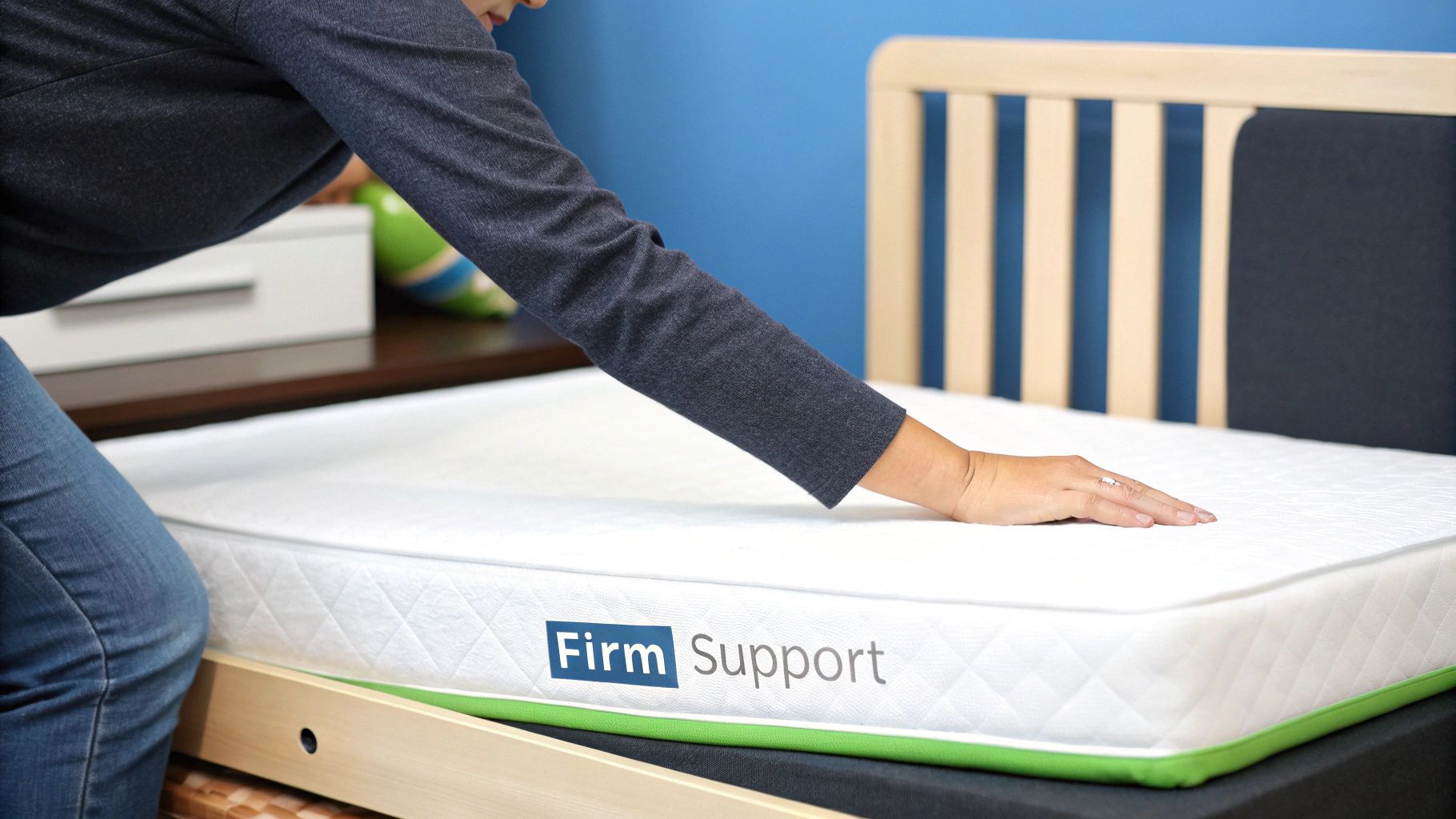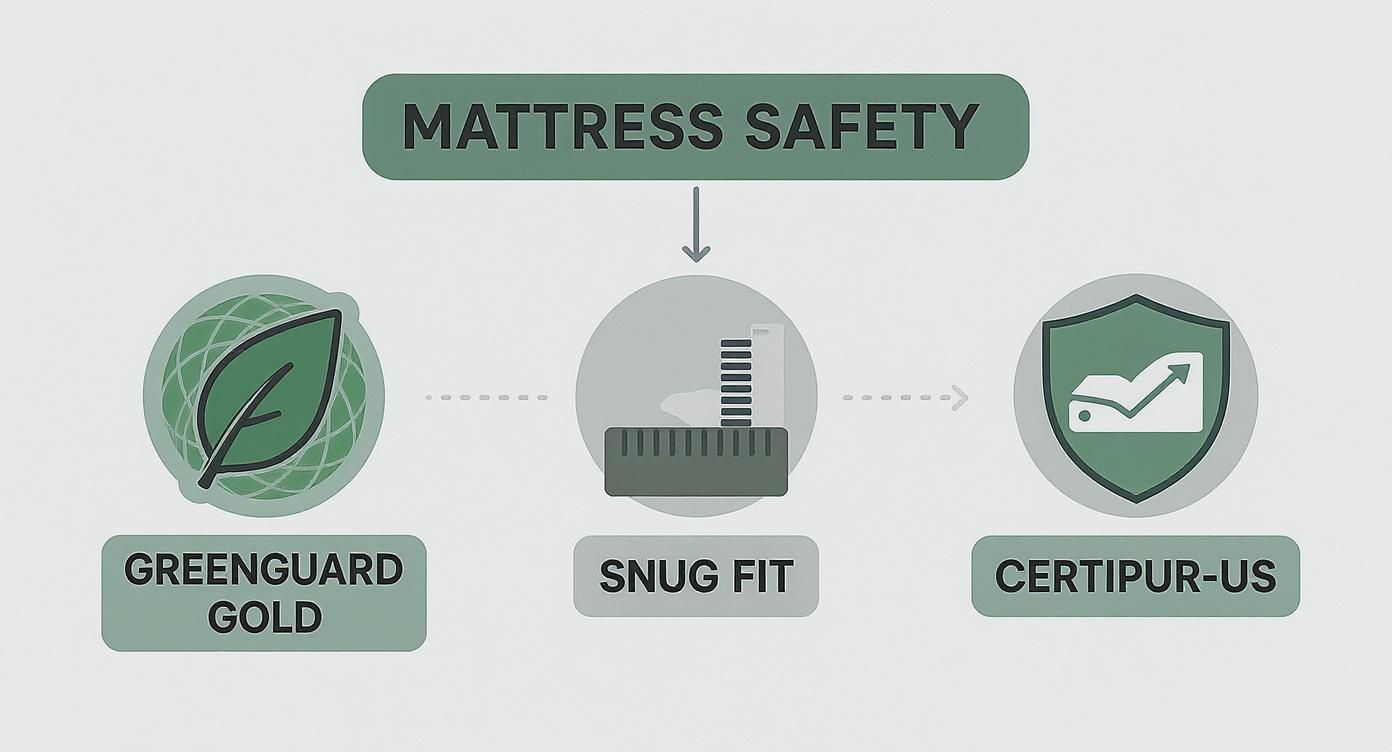
Best Mattress for Toddler Bed: Safe Sleep Guide
Share
When you're picking out the best mattress for a toddler bed, your number one priority should be a firm, supportive surface that comes with solid safety certifications. A great find is often a dual-sided mattress, built with an extra-firm side for infants and a slightly softer side for toddlers. It's a smart way to get more bang for your buck while supporting your little one's development.
Your Guide to a Safe and Sound Toddler Bed

Making the switch from a crib to a toddler bed is a huge deal! We tend to focus on the bed frame, but the mattress is the real hero here—it's the foundation for healthy growth and peaceful nights.
This guide will help you look past the fluff and focus on what really counts. And if you're still deciding on the bed itself, you can check out our comparison of a floor bed vs crib to help with that big step. The goal here is simple: find a mattress that's safe, durable, and free from nasty chemicals. Knowing what to look for makes the whole process a lot less overwhelming.
To help you cut through the noise, we've put together a quick guide summarizing the most important things to consider.
Quick Guide to Toddler Mattress Features
| Key Feature | Why It Matters | What to Look For |
|---|---|---|
| Firmness | A firm surface prevents sinking and supports a toddler’s growing spine and bones, reducing suffocation risks. | Press on the mattress; it should snap back quickly without conforming too much to the shape of your hand. |
| Safety Certifications | These ensure the mattress is free from harmful chemicals and has low VOC emissions for cleaner indoor air. | Look for GREENGUARD Gold and CertiPUR-US labels on the product tag or description. |
| Materials | Non-toxic, breathable materials are safer and often more durable for long-term use. | Organic cotton, wool, or high-density foam are excellent, durable choices. |
| Size & Fit | A snug fit inside the bed frame eliminates dangerous gaps where a child could get trapped. | Measure your bed frame and aim for a mattress that leaves no more than two fingers of space between it and the frame. |
| Waterproof Cover | Accidents happen! A waterproof, washable cover protects the mattress from spills and keeps it hygienic. | Look for a removable, machine-washable cover made from non-crinkly, breathable material. |
Now that you have the big picture, let's dive a little deeper into what makes a great toddler mattress.
What Truly Matters in a Toddler Mattress
When you're on the hunt for the best mattress for a toddler bed, zero in on these non-negotiables:
- Safety First: Always look for certifications like GREENGUARD Gold and CertiPUR-US. These aren't just fancy stickers; they guarantee the mattress has low chemical emissions, which means cleaner, healthier air for your child to breathe while they sleep.
- Firm is Best: A firm mattress is crucial. It provides the right support for a toddler's developing spine and bones and, most importantly, prevents the dangerous sinking that can pose a suffocation risk.
- Good, Clean Materials: Opt for high-quality, non-toxic materials. Things like organic cotton or wool are fantastic because they're durable, breathable, and safe for your little one.
As your child grows, navigating toddler sleep transitions is a whole journey in itself, and the right mattress can make it smoother. It’s no surprise that parents are demanding safer products; the baby mattress market was valued at an impressive USD 1.16 billion in 2024, showing just how important this choice has become.
Why Firm Support Is a Toddler's Best Friend

It's one of the biggest myths out there: that a soft, plush bed is the key to comfort for a toddler. But when it comes to your little one, you have to think differently. The single most important feature of a toddler mattress is firm support.
Think of your toddler's growing body like a house under construction. It needs a rock-solid foundation, not a soft, sandy base that can shift and sag. A firm mattress provides a consistently stable, flat surface that their developing bones and spine need for proper alignment.
Unlike adults, toddlers just don't have the muscle strength to easily push themselves out of a dip or reposition if they sink into a soft mattress. This isn't just a comfort issue—it's a serious safety risk.
Putting Firmness to the Test
So, how can you be sure a mattress is truly "firm" enough? It can feel like a subjective term, but a couple of simple, hands-on tests will give you a clear answer. Don't be shy about testing a mattress out before you commit!
You can do these quick checks in the store or the moment you unbox a new mattress at home:
- The Hand Press Test: Push down hard in the center of the mattress with your palm, then let go. A properly firm mattress will snap back into place almost immediately. If it slowly returns to form or holds the shape of your hand for a moment, it’s too soft.
- The Edge Test: Press down firmly on the edges and corners. A quality toddler mattress will offer consistent support across the entire surface. If the sides sag or collapse easily, it’s a no-go. This is crucial for safety, especially if your child rolls to the edge while sleeping.
A truly supportive toddler mattress provides a level plane for development. It shouldn’t feel like a fluffy cloud but rather a resilient, stable platform that supports every inch of their small frame without creating dips or sinkholes.
Remember, what feels uncomfortably firm to you is often just right for a small child. This level of support is non-negotiable for both their safety and healthy development. It gives them the solid surface they need to move, roll, and push themselves up without getting stuck, which is absolutely essential for a safe sleep environment.
Decoding Toddler Mattress Safety Standards
Trying to make sense of toddler mattress safety standards can feel like learning a new language. You're suddenly faced with a whole alphabet soup of certifications, and it's easy to get overwhelmed. But these labels are way more than just marketing fluff; they're your guarantee that the mattress is a safe, healthy place for your little one to sleep.
Think of these certifications as a detailed background check on the mattress. They confirm that the materials used are free from nasty chemicals, heavy metals, and other toxins you definitely don't want anywhere near your child. Considering your toddler will spend a huge chunk of their day on this surface, getting this part right is non-negotiable.
Key Certifications to Look For
As you start comparing different mattresses, keep an eye out for these gold-standard labels. Each one tests for slightly different things, but when you see them together, you can be confident you're looking at a genuinely safe product.
- GREENGUARD Gold: This is one of the toughest certifications out there. It means the mattress has been tested for over 10,000 chemicals and has super low emissions of volatile organic compounds (VOCs). Lower VOCs mean cleaner, healthier air in your child's room.
- CertiPUR-US®: This one is specifically for foam mattresses. It's your assurance that the foam is made without ozone depleters, heavy metals like mercury and lead, or nasty flame retardants. It also confirms the foam has low VOC emissions.
- OEKO-TEX® Standard 100: This label takes a close look at every single component of the mattress—we're talking everything from the fabric cover right down to the thread. It certifies that each piece has been tested for harmful substances and is completely safe for human health.
Thankfully, as parents have become more educated about sleep quality and safe materials, the market has responded. The demand for products meeting strict standards from organizations like the CPSC has pushed the toddler mattress industry to innovate and offer better, safer options.
To make this a little easier to digest, here's a quick breakdown of what these common certifications really mean for your family.
Key Safety Certifications Explained
Understand what the most common safety and material certifications mean for your child's mattress.
| Certification | What It Guarantees | Why It's a Must-Have |
|---|---|---|
| GREENGUARD Gold | The product has been tested for over 10,000 chemicals and has low VOC emissions. | Ensures cleaner indoor air quality, which is crucial for a developing child's respiratory system. |
| CertiPUR-US® | For foam products, it certifies the foam is free from heavy metals, phthalates, and formaldehyde. | Guarantees the foam components aren't off-gassing harmful chemicals while your child sleeps. |
| OEKO-TEX® Standard 100 | Every component (fabric, thread, zippers) is tested and proven free from harmful substances. | Provides comprehensive safety, assuring you that nothing toxic is touching your child's skin. |
Seeing these labels on a mattress should give you a major confidence boost that you're making a healthy choice for your little one.
The Critical Importance of a Snug Fit
Beyond the materials inside, the physical fit of the mattress is just as important. A toddler mattress must fit snugly inside the bed frame, with no gaps along the sides. Any space between the mattress and the frame is a serious entrapment hazard for a small, curious child.
A great rule of thumb is the "two-finger test." If you can easily slide more than two fingers between the mattress and the bed frame, the mattress is too small and poses a safety risk.
This simple test ensures there are no dangerous gaps where a child could get stuck. Before you buy, take a moment to measure the interior dimensions of your toddler's bed and compare them against the mattress specs. This guarantees you'll get that perfect, safe fit. And while materials are key, it's also worth looking into options like a breathable crib mattress, which can add another layer of safety and peace of mind.
Choosing Your Material: Foam Versus Innerspring
So, you’re on the hunt for the perfect toddler mattress. One of the first big decisions you'll face is whether to go with foam or a traditional innerspring model. Honestly, both can be fantastic choices, but they feel and function quite differently. Your decision will probably boil down to what you value most—things like weight, how long you need it to last, and just plain personal preference.
Foam mattresses are a parent-favorite for one simple reason: they’re incredibly lightweight. If you’ve ever tried to change crib sheets in the middle of the night, you know what a lifesaver it is to lift the mattress with one hand. They also tend to be a bit more budget-friendly while still offering firm, consistent support from corner to corner.
Then you have innerspring mattresses, built with a classic network of steel coils. This design makes them super durable and lets air flow freely, which is great for keeping your little one cool. Many parents just prefer that traditional, slightly bouncy feel and the super-sturdy edges that innerspring provides.
Breaking Down Foam Mattresses
If you’re leaning toward foam, the most important thing to look at is density. A higher-density foam will give your toddler better support and is much less likely to sag or get permanent body indentations over time. Also, keep an eye out for a CertiPUR-US® certification. This little label is your assurance that the foam was made without a list of nasty chemicals and has low VOC emissions, which is great for your home’s air quality.
This infographic shows a few of the key safety certifications you'll want to see, no matter what kind of mattress you choose.

Seeing these labels means you can rest easy knowing the mattress meets strict standards for both its materials and any chemical emissions.
Understanding Innerspring Mattresses
With innerspring, it’s all about the coils. You’ll want to check two key specs: coil count and steel gauge. Generally, a higher coil count offers more points of support across the mattress. The steel gauge tells you how thick the wire is—and here, a lower number is actually better because it means the wire is thicker and more durable. Together, these factors create that firm, resilient surface that can stand up to years of jumping and sleeping.
There's a lot of debate around which is better, and you can dive deeper into the spring mattress vs foam mattress conversation to get all the details.
A simple way to think about it is this: foam offers lightweight convenience and uniform support, while innerspring provides traditional durability and superior airflow. Neither is inherently better—the best choice depends entirely on what matters most to your family.
Must-Have Features for Real Life With Toddlers

Once you’ve nailed down the core support and safety certifications, it's time to think about the messy reality of life with a toddler. This is where a few practical features become absolute lifesavers, saving you a whole lot of time and stress down the road.
When it comes to a toddler mattress, two features are totally non-negotiable: waterproofing and breathability. Just think of a waterproof cover as the essential insurance policy for your new mattress. It’s your main shield against the inevitable spills, leaks, and potty-training accidents that are just part of the journey.
The Power of a Waterproof Protector
A good waterproof layer does so much more than just keep the surface of the mattress dry. It stops liquids from seeping deep into the core, which is absolutely critical for preventing mold, mildew, and bacteria from growing inside. This simple feature protects your investment and keeps their sleep space hygienic.
If you’re worried about crinkly, plastic-like noises, don’t be. Modern protectors are often made from soft, quiet materials that won't disrupt your little one's sleep. It’s an easy addition that makes cleanup a breeze.
A waterproof mattress is your first line of defense against messes. It's not just about convenience; it’s about maintaining a clean, healthy, and durable sleep environment for your child through every stage.
Why Breathability Matters
Breathability is just as important. Toddlers can have a tough time regulating their body temperature, and a mattress that traps heat can lead to sweaty, restless nights. Nobody wants that!
A breathable design allows for better airflow, which helps move heat away from your child and keeps them comfortable. Look for mattresses with features like perforated foam or covers made from organic cotton, since these materials are great for maintaining a cool sleep surface. This kind of thoughtful design really does lead to better, more restorative sleep for everyone.
A comfy and practical mattress also plays a key part when you're transitioning from a crib to a bed, helping to make the whole process a little smoother.
Your Top Questions About Toddler Mattresses
Stepping into the world of toddler beds can feel like it comes with a whole new rulebook. As you make the big move from the crib, it’s completely normal to have questions about what gear you can reuse and when it's time for something new. Let's tackle some of the most common concerns parents have.
Can I Use a Crib Mattress in a Toddler Bed?
Yes, you absolutely can—and you should, as long as it’s still in great condition. Federal safety regulations mandate that standard crib and toddler mattresses must have the same minimum dimensions: 27 1/4" x 51 1/4".
This rule is all about safety. It ensures a snug, gap-free fit in both cribs and toddler bed frames, which is critical for preventing accidents. So, if your current crib mattress is still firm, supportive, and doesn't have any sags, it’s perfectly safe to keep using it. No need to buy a new one just for the sake of it!
What Is a Dual-Sided Mattress?
You might come across "dual-sided" or "2-stage" mattresses during your search. These are pretty clever designs that essentially offer two mattresses in one.
- One side is extra-firm, designed specifically for the safety of infants to reduce SIDS risk.
- The other side is a bit softer, offering more cushion and comfort for a growing, active toddler.
These are a fantastic investment if you're buying for a newborn and plan to use the same mattress for years. But if you’re buying a mattress for a child who is already a toddler, a high-quality, single-firmness mattress is all you really need and is often a more budget-friendly choice.
The main takeaway here is that while versatility is nice, a consistently firm and supportive surface is what truly matters for your toddler. Don't feel pressured to get a dual-sided model if a great single-sided one fits the bill.
When Should I Replace My Toddler's Mattress?
It's time for a new mattress the moment you spot any real signs of wear and tear. A mattress that can't provide a firm, flat surface is no longer a safe sleep space for a little one.
Keep an eye out for these red flags:
- Obvious sagging, especially in the middle where your child usually sleeps.
- Any lumps, bumps, or an uneven surface you can feel when you press down.
- Lingering odors or any signs of mold, particularly after nighttime accidents.
A good quality mattress should easily last through the toddler years for one child. If you're thinking of passing it down to a younger sibling, just be sure to give it a thorough check-up first to make sure it’s still firm and supportive enough.
At Ocodile, we believe in creating spaces where children can thrive safely and confidently. Our Montessori-inspired floor beds are built to pair perfectly with standard toddler mattresses, fostering independence and sweet dreams. Take a look at our collection to find the ideal foundation for your little one's big-kid room at https://ocodile.com.








